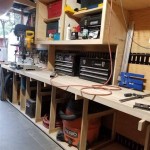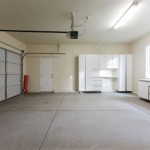Garage Ceiling Lighting Ideas For Small Rooms
Effective garage lighting is essential for safety, functionality, and overall usability, particularly within smaller spaces. A well-lit garage maximizes visibility for tasks like vehicle maintenance, storage organization, and hobby projects. Inadequate lighting can lead to accidents, difficulty locating items, and an overall feeling of claustrophobia. Therefore, selecting the appropriate ceiling lighting options that optimize brightness, energy efficiency, and space utilization is crucial for a comfortable and productive small garage environment.
The limited square footage of a small garage necessitates careful consideration of lighting fixtures and placement. Overly large or bulky fixtures can clutter the space and reduce headroom, while poorly positioned lights can create shadows and uneven illumination. Consequently, the selected lighting solutions should be compact, efficient, and strategically arranged to maximize light output and minimize visual obstruction. Optimizing ceiling lighting can transform a cramped garage into a well-organized and functional area.
Understanding Light Output and Color Temperature
Before selecting specific lighting fixtures, it is imperative to understand the concepts of light output and color temperature. Light output, measured in lumens, quantifies the total amount of visible light emitted by a light source. A higher lumen rating signifies a brighter light. The required lumen output for a garage depends on the intended use of the space. General ambient lighting requires fewer lumens per square foot compared to task lighting for detailed work. For example, an area used solely for parking might require 30-50 lumens per square foot, while a workbench area would benefit from 75-100 lumens per square foot.
Color temperature, measured in Kelvin (K), describes the warmness or coolness of the light emitted. Lower Kelvin values (2700K-3000K) produce a warm, yellowish light, whereas higher Kelvin values (4000K-5000K) produce a cooler, whiter light. For garages, a cooler color temperature is generally preferred. The whiter light enhances visibility, reduces eye strain, and provides better color rendering, which is particularly important for tasks like painting or automotive repairs. A color temperature between 4000K and 5000K is often recommended for optimal garage lighting.
Selecting bulbs with appropriate lumen output and color temperature is critical for achieving desired lighting levels and visual comfort. LED bulbs are often preferred due to their energy efficiency, long lifespan, and availability in a wide range of lumen outputs and color temperatures. Incandescent and halogen bulbs are less energy-efficient and have shorter lifespans compared to LEDs, making them less suitable for garage lighting applications.
Popular Ceiling Lighting Options for Small Garages
Several ceiling lighting options are well-suited for small garages, each offering distinct advantages and disadvantages in terms of brightness, energy efficiency, ease of installation, and cost. Choosing the most appropriate option depends on the specific needs and budget of the property owner.
Fluorescent Tube Lights: Fluorescent tube lights, particularly T5 and T8 fixtures, have been a common choice for garage lighting due to their relatively high light output and energy efficiency compared to older incandescent options. These fixtures are typically installed in rows or grids to provide uniform illumination across the garage. However, fluorescent lights can flicker, especially when they are old or cold, and they contain mercury, requiring special disposal procedures. LED tube lights, which are designed to replace fluorescent tubes, offer a more energy-efficient and environmentally friendly alternative.
LED Shop Lights: LED shop lights are lightweight, linear fixtures that provide bright, even illumination. They are typically suspended from the ceiling using chains or mounted directly to the ceiling surface. LED shop lights are energy-efficient, have a long lifespan, and are available in various lengths and lumen outputs. They are also relatively inexpensive and easy to install, making them a popular choice for garage lighting. Look for shop lights with a durable housing and a high color rendering index (CRI) for accurate color representation.
LED Wraparound Lights: LED wraparound lights are surface-mounted fixtures that provide a wide distribution of light. They are typically installed flush with the ceiling, making them a good option for low-ceiling garages. Wraparound lights are energy-efficient, have a long lifespan, and are available in various sizes and lumen outputs. Their enclosed design protects the light source from dust and debris, which is beneficial in a garage environment. Additionally, their aesthetic is generally more appealing compared to basic shop lights.
LED Flush Mount Lights: Flush mount lights are mounted directly to the ceiling, providing minimal protrusion into the space. This makes them a good option for garages with low ceilings where headroom is a concern. LED flush mount lights are energy-efficient, have a long lifespan, and are available in a variety of styles and finishes. While they may not provide as much light output as some other options, multiple flush mount lights can be strategically placed to achieve adequate illumination throughout the garage.
LED High Bay Lights: Although typically used in large commercial spaces, smaller LED high bay lights can be appropriate for garages with high ceilings. These lights provide powerful illumination and are designed to distribute light evenly over a wide area. They are energy-efficient and have a long lifespan. However, high bay lights may be overkill for smaller garages with standard ceiling heights and could create excessive glare if not properly positioned.
Strategic Lighting Placement and Control
Effective lighting placement is just as important as selecting the right fixtures. A well-designed lighting plan minimizes shadows, maximizes light output, and ensures adequate illumination for all tasks. Proper lighting control, such as dimmers and motion sensors, also contributes to energy efficiency and convenience.
Layered Lighting: Implementing a layered lighting approach is beneficial, especially in a multifunction garage. This involves combining ambient lighting, task lighting, and accent lighting to create a balanced and functional lighting scheme. Ambient lighting provides overall illumination for the garage, while task lighting focuses on specific work areas, such as a workbench or tool storage area. Accent lighting can be used to highlight specific features or add visual interest. Layered lighting allows for flexible control and adaptability to different tasks and activities.
Task Lighting: Task lighting is crucial for areas where detailed work is performed. Under-cabinet lighting or clamp-on work lights can be used to provide focused illumination on workbenches, toolboxes, or other work surfaces. These lights should be adjustable and provide adequate brightness to reduce eye strain and improve visibility. Task lighting complements the overall ambient lighting and ensures optimal illumination for specific tasks.
Placement Considerations: The placement of lighting fixtures should take into account the layout of the garage, the location of obstacles, and the direction of natural light. Avoid placing lights directly above frequently used walkways or work areas to minimize glare. Consider the angle of the light and adjust the position of fixtures to minimize shadows and provide even illumination. Placing lights near the garage door can improve visibility when entering and exiting the garage at night.
Lighting Controls: Installing dimmers allows for adjusting the brightness of the lights to suit different tasks and moods. Dimmers can also save energy by reducing the amount of light output when full brightness is not required. Motion sensors can automatically turn the lights on when someone enters the garage and off when no one is present, further enhancing energy efficiency and security. Consider using smart lighting systems that can be controlled remotely via a smartphone or voice assistant.
Safety Considerations: When installing or modifying garage lighting, safety should be a primary concern. Always disconnect the power before working on electrical wiring. Use appropriate wiring and connectors that are rated for the intended use. Consider using a licensed electrician for complex or potentially hazardous installations. Ensure that all lighting fixtures are properly grounded and that they meet safety standards outlined by local building codes.
Optimizing garage ceiling lighting in small rooms requires careful planning and selection of appropriate fixtures. By understanding light output, color temperature, and the advantages of different lighting options, property owners can create a well-lit, functional, and safe garage environment. Strategic placement, layered lighting, and effective lighting controls further enhance the usability and energy efficiency of the space. Prioritizing safety during installation and adhering to building codes ensures a secure and compliant lighting system.
:max_bytes(150000):strip_icc()/248097242_1912699488893277_7341301168849644704_n-21c40c5c504841bbb1adbf3aea19a463.jpg?strip=all)
12 Garage Lighting Ideas

8 Garage Lighting Ideas To Illuminate Your Space

10 Converted Garage Bedroom Ideas You Don T Want To Miss

8 Best Basement Lighting Ideas For A Remodel

10 Converted Garage Bedroom Ideas You Don T Want To Miss

Garage Ceiling Ideas For A Bright Finished Space Trusscore

2 Pack 300w Led Deformable Garage Ceiling Lights Plug In 6500k Hanging Lamp Corded Light

40 Above Garage Bonus Room Ideas Maximize Your Extra Space

Bright Ideas For Basement Lighting Renoassistance

Transform Your Garage Into An Extension Of Home S Living Space Amarr Doors
Related Posts








